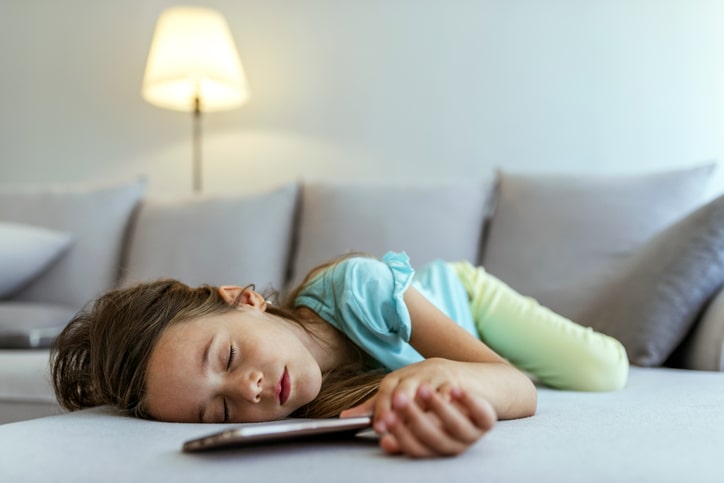5 Ways to Transition Kids to a Back-to-School Sleep Schedule

After a long summer of going with the flow, later nights, and unstructured days, it can be tough for kids and parents to go back to a regular sleep schedule. Sleep is one of the most common sources of stress for parents and kids when heading back to school.
Read on to learn about the importance of a back-to-school sleep routine, how inadequate sleep affects kids’ performance and health and proven ways to help kids and teens establish a sleep routine that they can consistently stick to and won’t leave them tired or cranky in the mornings.
Related: 3 Tips for a Stress-Free School Morning Routine
Importance of a Back-to-School Sleep Routine
Going from summer vacation to starting school can significantly affect sleep quality and duration. During the summer, families had more relaxed schedules which included staying up later, sleeping in later and/or waking up at irregular times.
How Sleep Affects Kids’ School Performance and Health
Helping kids adjust to a school sleep schedule is essential for optimal academic performance and health. The shift to earlier mornings can disrupt circadian rhythms. The circadian rhythm is our internal clock that manages all the essential functions and processes involved in our body’s sleep-wake cycle.
The circadian rhythm has been shown to impact the immune system and is associated with the risk of cancer and mental health disorders such as depression, dementia, and bipolar disorder.
Inadequate sleep has been shown to increase the risk of cardiovascular disease, depression, diabetes, obesity, hyperactivity, irritability, and issues with attention, memory, concentration, decision-making and problem-solving.
“[When school starts], many kids may have difficulty falling asleep at an earlier bedtime and feel groggy when it’s time to wake up in the morning,” explains Annie Miller, a licensed psychotherapist, owner and founder of DC Metro Sleep and Psychotherapy.
Lacking energy and feeling fatigued in the morning can create problems with concentration, memory and information retention at school. We’ve all felt the struggle of staying on top of tasks and conversations when we haven’t had a good night’s rest. It’s no different for kids.
Miller who specializes in working with sleep disorders, chronic pain, and trauma and uses a variety of evidence-based techniques including CBT-i for insomnia, EMDR for trauma, and PRT (pain reprocessing therapy) for chronic pain shared, “Starting the school year without a consistent sleep schedule can make it harder for kids to be able to focus and can impact their overall mood.”
Recommended Hours of Sleep for Kids by Age
The American Academy of Sleep Medicine (AASM) recommends the following guidelines for how much sleep your child needs:
Four to 12 months: 12–16 hours (including naps)
One to two years: 11–14 hours (including naps)
Three to five years: 10–13 hours (including naps)
Six to 12 years: 9–12 hours
13 to 18 years: 8–10 hours
Getting enough sleep is critical for academic success as well as overall well-being. When creating a sleep schedule, keep the age of your child in mind to determine the appropriate amount of sleep that is necessary for a happy and healthy kid.
How to Transition Kids to a School Sleep Schedule
Ideally, you shouldn’t wait until the first day of school to help your kids adjust to a school sleep schedule. They won’t be able to jump right into their old routines. They need time to adjust.
Instead, start the transition early, giving them plenty of time to adapt to the upcoming changes so they feel rested, physically prepared and ready when school starts. Here are 5 ways to help your kids get back to a school sleep schedule.
1. Practice Waking Up Weeks Before
Chances are the days of summer entail lazy wakeups and later bedtimes. Therefore, during the weeks leading up to the start of school, it’s important to give your kids time to gradually readjust their sleep schedules. This means starting the wake-up process a little earlier each day as you lead up to the start of school.
If you start the transition early, it will feel less abrupt when the school year starts.
“The key is to be consistent and set a wake time that you can stick to every day. And gradually push the wake time earlier by 15 minutes until you get to the time your child has to wake up for school,” explains Miller.
Establishing a before-school routine, such as prepping outfits and lunches the night before, allows kids sufficient time to get ready before school starts.
Set a consistent wake-up time that allows for a good night’s sleep but still enough time for your child to shake off the sleepiness before heading out the door.
“If you start to make these adjustments several weeks in advance of school starting, it will help promote optimal sleep quality for the school year,” advises Miller.
Consult with your pediatrician if necessary so that you are confident you are setting the foundation for healthy sleep habits.
2. Limit Screen Time Before Bed

It’s not a myth that electronics can affect sleep. Studies have shown devices such as TVs, tablets, computers, laptops, video game devices and cell phones emit blue light that suppresses melatonin production in our bodies. This causes us to feel awake at bedtime which negatively affects the quality of our sleep.
The best rule of thumb is to eliminate screen time an hour before kids head to bed. This is typically easier for younger kids because they do not own cell phones; parents can take away devices and put them in a place that they cannot access.
Be sure to focus on the benefits of limiting screen time such as the opportunity to chat with family, read a book, draw and play with their toys. You don’t want them to feel like they are being punished.
However, most teenagers own cell phones and do homework on a laptop. Talk to your teen about what they think an appropriate screen time cut-off would be. Emphasize that they want to be intentional with creating a new schedule by brainstorming ways to help them prioritize their time during the day so they don’t need to use devices an hour before bedtime.
3. Enjoy Relaxing Activities Before Bedtime
Now that you are working to eliminate screens prior to bedtime, shift to providing relaxing activities that will help your child wind down and decompress.
For younger children, this can be independent quiet play, coloring, a warm bath, working on puzzles, chatting about the day, Play-Doh, LEGOS, singing or listening to music.
For adolescents and teenagers, this can be a wonderful opportunity to get to know their hobbies and interests. You can go on an evening neighborhood walk with them. Suggest audiobooks and podcasts to listen to.
They can try gentle yoga stretches, breathing activities, meditation or mindfulness exercises. Take the time to ask about what activities they would like to do. It’s easier for teenagers to stick to a plan if they came up with it themselves.
4. Establish a Consistent Bedtime Routine
Start the new school year off with a consistent bedtime routine that creates predictability for your child.
“Having a consistent routine is essential. Make sure to wake up at the same time, even on weekends, use the bed only for sleep, keep 1–2 hours for winddown time at night, and don’t lie in bed if you can’t sleep,” explains Miller.
If you need earlier bedtimes, then you need to be starting your sleep routine earlier so that everything is completed and your child is climbing into their bed at the time you set, not starting a lengthy process.
Set consistent bedtimes and wake-up times so that your child is able to meet the recommended hours of sleep.
An example of a great bedtime routine is taking a warm bath/showering, putting on pajamas, setting out clothes for the morning, brushing teeth, and reading a story.
If your child’s internal clock isn’t yet telling them they are tired, many of these parts of their routine will start to signal to their bodies that it’s time to unwind and get ready to sleep.
5. Create a Comfortable Sleep Environment
Creating a relaxing sleep environment is essential to good quality sleep.
“[T]ry to keep the bedroom cool, dark, and quiet,” advises Miller. Some ways to help achieve this include the following:
- Avoid having too many toys or electronics in the bedroom that could tempt your child from going to bed.
- Create a serene environment that is welcoming, clutter-free, calm and relaxing
- Install blackout curtains to block out light to help promote deep sleep
- Turn on a white noise machine that can help reduce external noises that can distract your child from falling asleep.
Sleep is an important part of your child’s growth and development. Going back to school can impact their sleep and contribute to health and school problems. However, you can make the transition easier and less stressful by working with your child to develop good sleep habits.

